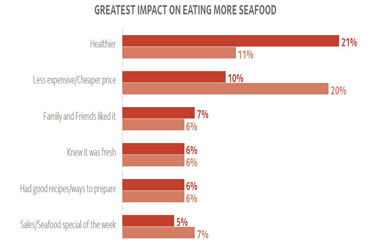Seafood sales at U.S. food retailers ramped up 28.4 percent in 2020 to reach USD 16.6 billion (EUR 13.7 billion), according to a new report.
Sales of the combined category of fresh, frozen, and shelf-stable seafood outpaced sales in the produce, meat, and deli department, according to the newly released edition of the Power of Seafood 2021 report from FMI – The Food Industry Association.
Health and wellness played a major role in seafood’s rising popularity. The survey found that one-third of U.S. consumers ate seafood two times per week in the past year, and 59 percent of people who upped their seafood intake said they had done so because were trying to eat healthier and boost their immune systems. Even people who previously ate lots of seafood were affected by the health trend, with 72 percent of frequent seafood consumers putting more effort into making healthy and nutritious choices since the start of the COVID-19 pandemic, according to the report. And seafood’s popularity will continue to increase as that trend becomes more pronounced, FMI Vice President of Fresh Foods Rick Stein told SeafoodSource.
“I do expect to see strong seafood sales in the future,” Stein said. “As shoppers focus on health and well-being, seafood is poised to continue to attract not only frequent seafood shoppers, but also shoppers cooking more at-home and seeking new culinary options and healthy protein solutions.”
Shoppers are eager to learn more about cooking seafood, the survey found – 75 percent of those surveyed said they want to be more knowledgeable about how to preparing and flavoring seafood. Stein said that number represents a call to action for retailers to expand their seafood-related educational programs.
“The call to action among grocers is to focus on seafood nutrition, cooking guidance, meal ideas, and sustainability both in-store and online as ways to maintain shopper interest in seafood,” Stein said.
While some seafood shoppers already rely on retailers’ seafood departments for guidance (20 percent) as well as grocery store websites or apps (18 percent); retailers can do to become shoppers’ go-to-resource, Stein said.
“I’ve seen grocers doing more online culinary education and even better integrating health and well-being into the e-commerce experience,” he said.
Consumers are also growing more concerned about seafood sustainability, with 71 percent saying they want to be more knowledgeable about seafood sustainability, and 41 percent naming the issue as a top factor in choosing whether or not they buy seafood, and in selecting which type of seafood they buy.
Grocers should expand their sustainable seafood programs and educational outreach to “better connect with the four in 10 seafood consumers that say seafood certifications have a major impact on their seafood purchases,” Stein said.
How their seafood was caught or where it is from is also important to some seafood consumers, according to Stein. Thirty-six percent of shoppers prefer wild-caught seafood, “often citing their perception that it is of higher quality, healthier, or more nutritious,” he said.
Alternatively, farm-raised seafood was named by a growing number of consumers (29 percent in 2020 versus 19 percent in 2019) prefer farm-raised seafood, as their preferred type, citing a variety of sustainability reasons along with their perception that farm-raised is healthier or more nutritious, according to Stein. In addition, 35 percent of seafood consumers said better traceability is a reason for preferring farm-raised seafood.
“I believe there is more acceptance about farm-raised seafood due to more awareness about farm-raised options,” he said. “Also, salmon is a major species in seafood and often farm-raised salmon is a lower price compared to wild-caught options.”
The report noted the arrival of plant-based seafood analogs have arrived in the mainstream of consumer recognition and acceptance. Overall, 46 percent of seafood consumers said they are likely to try plant-based seafood analogs, while 31 percent are not likely to try them. Twenty-two percent said they are not sure. A majority – 59 percent – of frequent seafood consumers say they are likely to try plant-based seafood analogs.
“There is also a high correlation between an interest in plant-based fish and nutritious and healthy eating … and sustainability has a major impact,” the report said, citing its finding that 62 percent of consumers named sustainability as the top factor in their decision to try plant-based foods.
Chart courtesy of FMI - The Food Industry Association







